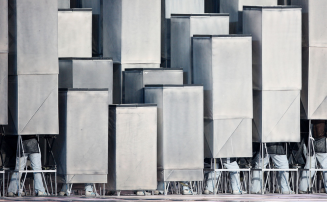|
Robotic Materials
We envision that materials in the
future will be embedded with many small smart devices
such as sensors, actuators, computing and
communication that will enable these materials to
morph their physical properties, such as shape,
volume, opacity, porosity, permeability,
elasticity/stiffness, strength, etc. Future
ubiquitous computing environments will be filled with
distributed embedded computing systems. We call
such materials smart materials, also known as
computational materials or robotic materials.
A key direction of interest to us is making these
robotic materials wireless in terms of their power and
communication. Wires bring many disadvantages,
such as weight, stiffness, breakage, cost, etc.
Wireless powering of robotic materials will free these
materials to morph their physical properties without
such constraints. We
have published recent work on wireless robotic
materials at:
- Nikolaus
Correll, Prabal Dutta, Richard Han, Kris Pister, "Wireless
Robotic Materials", ACM SenSys 2017,
Article 24, 6 pages,doi>10.1145/3131672.3131702.
For more on
computational materials, see the recent Workshop
on Robotic Materials held at CU Boulder on
March 2017.
To control such smart materials, we are
investigating distributed pattern recognition
algorithms that can recognize gestures using a network
of distributed simple sensors and actuators - forming
a Smart Wall. We have thus far built a multicast
protocol that self-organizes islands of
sensor/actuators who recognize the same gesture.
We have simulated and
implemented this algorithm in an actual smart
wall. More details can be found at the Correll Lab's
Web site. This work has been published as
follows:
- Homa
Hosseinmardi, Akshay Mysore, Nicholas Farrow,
Nikolaus Correll, and Richard Han. 2015. Distributed
Spatiotemporal Gesture Recognition in Sensor
Arrays. ACM Transactions
on Autonomous and Adaptive Systems (TAAS),
volume 10, issue 3, Article 17 (October
2015), pp. 1-19.
DOI=http://dx.doi.org/10.1145/2744203
- Shang Ma,
Homa Hosseinmardi, Nicholas Farrow, Richard Han
and Nikolaus Correll, "Establishing
Multi-Cast Groups in Computational Robotic
Materials", The IEEE International
Conference on Cyber, Physical and Social
Computing, November 20-23, 2012, Proceedings
pending. (Invited paper)
- Homa
Hosseinmardi, Nikolaus Correll, Richard Han, "Bloom
Filter-Based Ad Hoc Multicast Communication in
Cyber-Physical Systems and Computational
Materials", The 7th
International Conference on
Wireless Algorithms, Systems,
and Applications (WASA),
2012. Lecture
Notes in Computer Science Volume 7405, 2012, pp 595-606.
(Invited paper)
|
The
"Holodeck" Project in Cyber-Physical
Systems:
Our
idea is to actuate a physical array or
grid of moving pixels, which we call moxels,
using Graphics Processing Units, or
GPUs. We find that this
GPU-based solution is cost-effective
and scalable, such that large grids
could be controlled to render physical
surfaces in a Holodeck-like
environment. Moreover, our
GPU-based approach allows us to
leverage existing graphics rendering
software technology to assist in the
physical rendering. However,
non-trivial modifications need to be
made to the graphics rendering
software.
An early version of this work was
published at the 1st Workshop on
Cyber-Physical Systems (WCPS), "Towards
Cyber-Physical Holodeck Systems Via
Physically Rendered Environments
(PRE’s)".
The Beijing Olympics Opening Ceremony
featured a version of our moxel
technology on the grand scale (right
top picture), but we admit that the
moxels were human actuated instead of
GPU actuated (right bottom picture).
|
|
|
|


